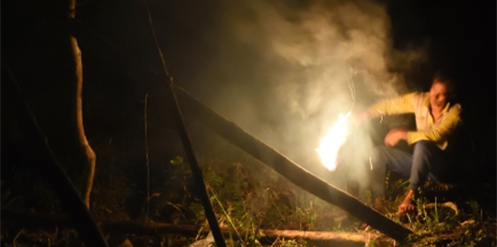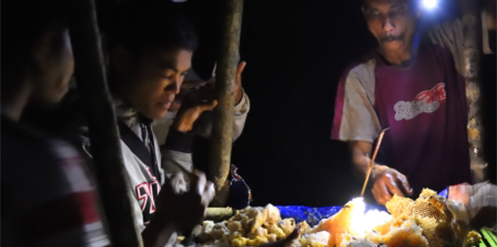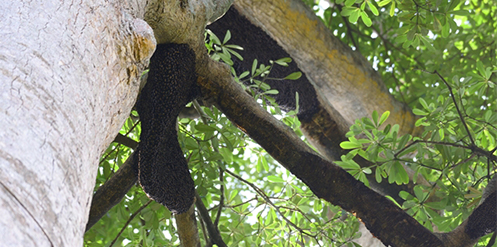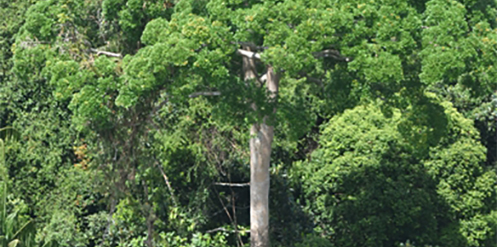January 12, 2018
One of the ways RER supports the local community is by encouraging the production of non-timber forest products. In December 2017, Brad Sanders, Operation Head of RER, headed to Dusun Sangar of Pulau Muda Village in Teluk Meranti to witness Sangar residents harvesting honey sustainably, a process RER supports to help local communities increase their income.
After a journey by helicopter, car and a hike through the peat forest, Brad met Pak Sadam, descendant of a long line of honey farmers and the leader of the 12-person group. Here Brad tells his story.
“As we walked in the mid-day sun, sweat began to moisten every pore of the skin due to the thick humidity that could even be felt in the shaded coolness of the rubber plantation. The peat soil was moist and soft along the well-worn trail that allowed us to move swiftly. We proceeded into the forest, following a freshly opened trail towards the honey tree grove. Large logs lay across our path, sticky vines, thorny trees, undulating roots hidden below fallen leaves and branches were interspersed with deep, wet holes of peat that more than once swallowed me or someone else up to our knees in cool, muddy soil. As we slowly trudged our way to our destination, Mahendra, my colleague, would periodically ‘hoot’ to the honey harvesters deeper in the forest, to confirm their location and announce our arrival.
When we arrived at the destination, we were welcomed by the busy men preparing wooden poles, braces and rattan tie straps to construct a ladder to the top of the massive sialang madu, a generic name for honey tree, measuring more than two-meters across at its base and 60-meters tall. This tree to be harvested tonight is known locally as Pulai rawa (Alstonia pneumatophora). The men had already cleared vegetation from a five-meter radius round the base of the tree, exposing the ‘breathing roots’ that are common for many trees in the flooded peatland.

One man stripped rattan into narrow, flexible three-meter lengths of tie-cord; some were cutting and preparing the 5-10 meter long climbing poles obtained from the surrounding forest trees; two men were already high up the tree, affixing the poles to the side of the towering icon shouting down to the others to send up additional materials. For now, the climbing ladder only extended up to the lowest branches where the first bee hives were located approximately 30-35 meters above the forest floor. The final extension through the branches to the top of the tree would only occur after dark without the aid of lights, so the climbers would avoid being stung by bees. While he stood off to the side, patiently and confidently observing the men, Pak Sadam told me how his father named the two trees most familiar to him, “This tree is ‘Petodak’ and another near-by tree is ‘Botak’. I do not know why they are given those names, it just always was that way”. He looked above and said to me his estimate of around 250 kg of honey may be harvested later. He continued saying that everyone knows this is his tree and everyone will respect that by not taking any honey from it, otherwise there is a severe fine of IDR4 million imposed by the village head. We all then took an afternoon rest, waiting for darkness to arrive.

My watch hit 7pm when the men resumed work again completing the unfinished ladder to the top. One man brought forward two, 1.5 meter long tubes of rolled tree bark to be ignited and used as an obor (torch) by the climbers to scare away the bees from the hive.
Not until 10.30pm we heard one man shouting “Siap, langsung naik!” (“It’s ready, climb now!”), all of us were in complete blackness as we immediately turned off all headlamps and lights from mobile phones. Only starlight could be seen through gaps in the forest canopy above. The sudden silence was surprising, deafening and seemed eternal for two to three minutes. Then suddenly, one of the men broke into song, in a deep and powerful tenor voice, using traditional ethnic-Melayu language, different sounding than traditional Indonesian language. He continued for 10 minutes, alternately and firmly touching the base of the tree and the climbing pole with his hands, and staring up to the top where the honey was waiting.

At the same time, another man began igniting one end of the rolled bark sticks, swooshing and blowing on the flames to ensure a steady stream of embers and smoke would be produced. Finally, a headlamp was turned on by one climber, casting a shadow on the other climber. The second climber individually placed each one of his open and spread hands just centimeters from the tree, without touching it, casting a shadow. Then, each of his bare feet were raised off the ground, laid flat against the bark of the tree, without touching the tree, just centimeters away, casting a shadow. The ceremony was done.
Both men draped straps over their shoulders that were tied to the burning bark torches. They rapidly and confidently ascended the tree like squirrels. Leaving the moist peat forest below, they disappeared up the side of the tree into the darkness, still singing the traditional song to give them strength, confidence and good results.
We were advised to move away, it would be too dangerous to remain at the base of the tree as the climbers would begin dropping embers and sections of beehive to the ground. As the climbers worked and sang above, a waterfall of glowing yellow-orange embers began to descend to the wet forest floor below. The men were using their obors to scare away the bees. Then suddenly, we could hear it, like a raging mass seemingly surrounding us, the bees were flying away from the hives. The resounding noise was intimidating for us on the ground, but soon we realized we were safe, the bees remained high over-head as we remained in the darkness.
After several minutes, the climbers above shouted and the other men immediately raised up the 20-liter plastic bucket using the nylon rope. Shortly, the bucket descended again and one of the other men on the ground carried the bucket, still tied to the rope, towards the coarse filter 10-meters away.

The excitement and anticipation of the preparations was now complete and reaching its crescendo. It took just more than one hour, the first batch of honey arrived, madu – madu – madu! The bucket was flipped over and emptied onto the coarse filter that was surrounded by at least six men. Immediately each man broke off a piece of the hive to taste the honey, some would shout manis (sweet), others would shout asam (acidy). Large chunks of waxy bee hive and dead bees were combined with the sweet, smooth and delectable nectar now being strained through a rattan screen, captured on a nylon sheet, then slowly funneled into a larger 30-liter plastic container. The men would squeeze the honey from the waxy hive with their hands to quickly extrude every last drop of honey they could. This first delivery yielded approximately 8-10 kilograms of honey. A few minutes later, a larger batch of bee hive arrived and the excitement continued. Drowned in the routine of excitement for few hours, I looked at my watch: it was already 4.30am. The hard but fun work was producing over 150kg of honey.
I was about to leave, all so full with excitement at having the privilege to observe and learn about traditions and practices for harvesting forest honey. I thanked them one by one for the experience. But before we departed they insisted we take home with us some of their honey. So we cleaned some used plastic water bottles and filled each one to the brim with honey, for as one of the villagers said, “Take it now tonight, for it is free, tomorrow you must pay!”